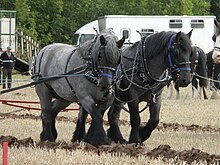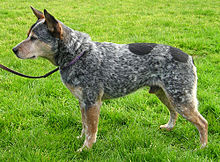
The American Paint Horse is a breed of horse that combines both the conformational characteristics of a western stock horse with a pinto spotting pattern of white and dark coat colors. Developed from a base of spotted horses with Quarter Horse and Thoroughbred bloodlines, the American Paint Horse Association (APHA) breed registry is now one of the largest in North America. The registry allows some non-spotted animals to be registered as "Solid Paint Bred" and considers the American Paint Horse to be a horse breed with distinct characteristics, not merely a color breed.
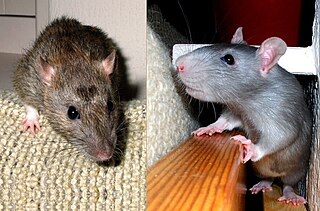
A dilution gene is any one of a number of genes that act to create a lighter coat color in living creatures. There are many examples of such genes:

A piebald or pied animal is one that has a pattern of unpigmented spots (white) on a pigmented background of hair, feathers or scales. Thus a piebald black and white dog is a black dog with white spots. The animal's skin under the white background is not pigmented.

Bay is a hair coat color of horses, characterized by a reddish-brown or brown body color with a black point coloration on the mane, tail, ear edges, and lower legs. Bay is one of the most common coat colors in many horse breeds.
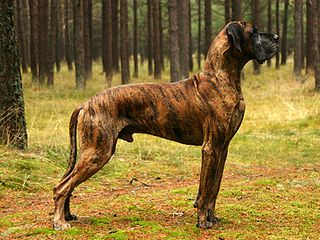
Brindle is a coat coloring pattern in animals, particularly dogs, cattle, guinea pigs, cats, and, rarely, horses. It is sometimes described as "tiger-striped", although the brindle pattern is more subtle than that of a tiger's coat.
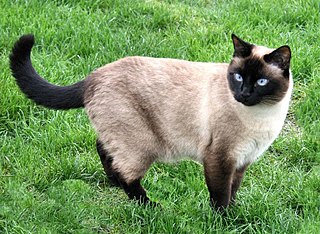
Point coloration is animal coat coloration with a pale body and relatively darker extremities, i.e. the face, ears, feet, tail, and scrotum. It is most recognized as the coloration of Siamese and related breeds of cat, but can be found in dogs, rabbits, rats, sheep, guinea pigs and horses as well.
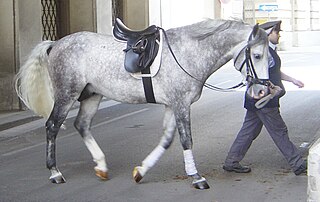
A gray horse has a coat color characterized by progressive depigmentation of the colored hairs of the coat. Most gray horses have black skin and dark eyes; unlike some equine dilution genes and some other genes that lead to depigmentation, gray does not affect skin or eye color. Gray horses may be born any base color, depending on other color genes present. White hairs begin to appear at or shortly after birth and become progressively more prevalent as the horse ages as white hairs become intermingled with hairs of other colors. Graying can occur at different rates—very quickly on one horse and very slowly on another. As adults, most gray horses eventually become completely white, though some retain intermixed light and dark hairs.

Equine coat color genetics determine a horse's coat color. Many colors are possible, but all variations are produced by changes in only a few genes. Bay is the most common color of horse, followed by black and chestnut. A change at the agouti locus is capable of turning bay to black, while a mutation at the extension locus can turn bay or black to chestnut.

Merle is a genetic pattern in a dog's coat and alleles of the PMEL gene. It results in different colors and patterns and can affect any coats. The allele creates mottled patches of color in a solid or piebald coat, blue or odd-colored eyes, and can affect skin pigment as well. Two types of colored patches generally appear in a merle coat: brown/liver and black. Associated breeds include Carea Leonés, Australian Shepherds and Catahoula Leopard Dogs. Health issues are more typical and more severe when two merle-patterned dogs are bred together.
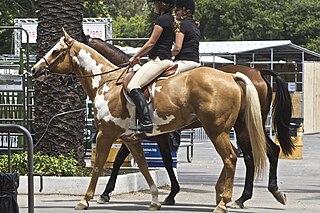
Overo refers to several genetically unrelated pinto coloration patterns of white-over-dark body markings in horses, and is a term used by the American Paint Horse Association to classify a set of pinto patterns that are not tobiano. Overo is a Spanish word, originally meaning "like an egg". The most common usage refers to frame overo, but splashed white and sabino are also considered "overo". A horse with both tobiano and overo patterns is called tovero.

Horses exhibit a diverse array of coat colors and distinctive markings. A specialized vocabulary has evolved to describe them.

A white horse is born predominantly white and stays white throughout its life. A white horse has mostly pink skin under its hair coat, and may have brown, blue, or hazel eyes. "True white" horses, especially those that carry one of the dominant white (W) genes, are rare. Most horses that are commonly referred to as "white" are actually "gray" horses whose hair coats are completely white. Gray horses may be born of any color and their hairs gradually turn white as time goes by and take on a white appearance. Nearly all gray horses have dark skin, except under any white markings present at birth. Skin color is the most common method for an observer to distinguish between mature white and gray horses.

Black is a hair coat color of horses in which the entire hair coat is black. Black is a relatively uncommon coat color, and it is not uncommon to mistake dark chestnuts or bays for black.

Sabino describes a distinct pattern of white spotting in horses. In general, Sabino patterning is visually recognized by roaning or irregular edges of white markings, belly spots, white extending past the eyes or onto the chin, white above the knees or hocks, and "splash" or "lacy" marks anywhere on the body. Some sabinos have patches of roan patterning on part of the body, especially the barrel and flanks. Some sabinos may have a dark leg or two, but many have four white legs. Sabino patterns may range from slightly bold face or leg white markings—as little as white on the chin or lower lip—to horses that are fully white.

Rabicano, sometimes called white ticking, is a horse coat color characterized by limited roaning in a specific pattern: its most minimal form is expressed by white hairs at the top of a horse's tail, often is expressed by additional interspersed white hairs seen first at the flank, then other parts of the body radiating out from the flank, where the white hairs will be most pronounced. Rabicano is distinct from true roan, which causes evenly interspersed white hairs throughout the body, except for solid-colored head and legs.

The leopard complex is a group of genetically related coat patterns in horses. These patterns range from progressive increases in interspersed white hair similar to graying or roan to distinctive, Dalmatian-like leopard spots on a white coat. Secondary characteristics associated with the leopard complex include a white sclera around the eye, striped hooves and mottled skin. The leopard complex gene is also linked to abnormalities in the eyes and vision. These patterns are most closely identified with the Appaloosa and Knabstrupper breeds, though its presence in breeds from Asia to western Europe has indicated that it is due to a very ancient mutation.

Dominant white (W) is a group of genetically related coat color alleles on the KIT gene of the horse, best known for producing an all-white coat, but also able to produce various forms of white spotting, as well as bold white markings. Prior to the discovery of the W allelic series, many of these patterns were described by the term sabino, which is still used by some breed registries.

Roan is a horse coat color pattern characterized by an even mixture of colored and white hairs on the body, while the head and "points"—lower legs, mane, and tail—are mostly solid-colored. Horses with roan coats have white hairs evenly intermingled throughout any other color. The head, legs, mane, and tail have fewer scattered white hairs or none at all. The roan pattern is dominantly inherited, and is found in many horse breeds. While the specific mutation responsible for roan has not been exactly identified, a DNA test can determine zygosity for roan in several breeds. True roan is always present at birth, though it may be hard to see until after the foal coat sheds out. The coat may lighten or darken from winter to summer, but unlike the gray coat color, which also begins with intermixed white and colored hairs, roans do not become progressively lighter in color as they age. The silvering effect of mixed white and colored hairs can create coats that look bluish or pinkish.

Dogs have a wide range of coat colors, patterns, textures and lengths. Dog coat color is governed by how genes are passed from dogs to their puppies and how those genes are expressed in each dog. Dogs have about 19,000 genes in their genome but only a handful affect the physical variations in their coats. Most genes come in pairs, one being from the dog's mother and one being from its father. Genes of interest have more than one expression of an allele. Usually only one, or a small number of alleles exist for each gene. In any one gene locus a dog will either be homozygous where the gene is made of two identical alleles or heterozygous where the gene is made of two different alleles.
The agouti gene, the Agouti-signaling protein (ASIP) is responsible for variations in color in many species. Agouti works with extension to regulate the color of melanin which is produced in hairs. The agouti protein causes red to yellow pheomelanin to be produced, while the competing molecule α-MSH signals production of brown to black eumelanin. In wildtype mice, alternating cycles of agouti and α-MSH production cause agouti coloration. Each hair has bands of yellow which grew during agouti production, and black which grew during α-MSH production. Wildtype mice also have light-colored bellies. The hairs there are a creamy color the whole length because the agouti protein was produced the whole time the hairs were growing.

